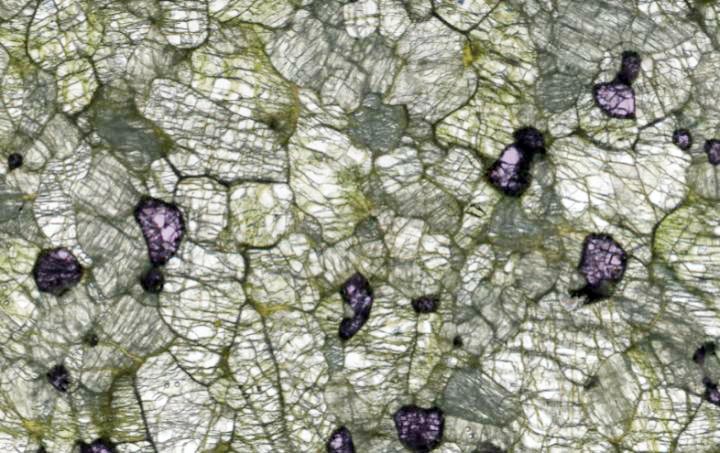A new, clearer insight into Earth’s hidden crystals

A transmitted light view through a 200-micron section of a peridotite sample, showing the three main minerals - olivine (clear-green), orthopyroxene (grey-green) and garnet (pink).
Credit: Dr Emma Tomlinson, Trinity College Dublin
Geologists have developed a new theory about the state of Earth billions of years ago after examining the very old rocks formed in the Earth’s mantle below the continents.
Assistant Professor Emma Tomlinson from Trinity College Dublin and Queensland University of Technology’s Professor Balz Kamber have just published their research in leading international journal, Nature Communications.
The seven continents on Earth today are each built around a stable interior called a craton, and geologists believe that craton stabilisation some 2.5 – 3 billion years ago was critical to the emergence of land masses on Earth.
Little is known about how cratons and their supporting mantle keels formed, but important clues can be found in peridotite xenoliths, which are samples of mantle that are brought to the Earth’s surface by erupting volcanoes.
Dr Tomlinson, from Trinity’s School of Natural Sciences, said:
“Many rocks from the mantle below old continents contain a surprising amount of silica – much more than is found in younger parts of the mantle.”
“There is currently no scientific consensus about the reason for this.”
The new research, which looks at the global data for mantle peridotite, comes up with a new explanation for this observation.
The research used a new thermodynamic model to calculate that the unusual mineralogy developed when very hot molten rock– greater than 1700 °C – interacted with older parts of the mantle and this caused the growth of silica-rich minerals.
“For more than 1 billion years, from 3.8 to 2.5 billion years ago, volcanoes also erupted very unusual lavas of very low viscosity – lava that was very thin, very hot and often contained variable levels of silica,” Dr Tomlinson added.
“Our modelling suggests that the unusual lavas were in fact the molten rocks that interacted with the mantle at great depth and this interaction resulted in the variable level of silica.”
Professor Kamber, QUT, said:
“Both the silica-rich rocks in the deep mantle and the low viscosity volcanic rocks stopped being made by the Earth some 2.5 billion years ago. This timing is the boundary between the Archaean and Proterozoic eons – one of the most significant breaks in Earth’s geological timescale.”
What caused this boundary remains unknown, but the research offers a new perspective.
Professor Kamber added:
“This may have been due to a change in how the mantle was flowing. Once the mantle started slowly turning over all the way down to the core (2,900 km), the very high temperatures of the Archaean eon were no longer possible.”
All latest news from the category: Earth Sciences
Earth Sciences (also referred to as Geosciences), which deals with basic issues surrounding our planet, plays a vital role in the area of energy and raw materials supply.
Earth Sciences comprises subjects such as geology, geography, geological informatics, paleontology, mineralogy, petrography, crystallography, geophysics, geodesy, glaciology, cartography, photogrammetry, meteorology and seismology, early-warning systems, earthquake research and polar research.
Newest articles

Innovative 3D printed scaffolds offer new hope for bone healing
Researchers at the Institute for Bioengineering of Catalonia have developed novel 3D printed PLA-CaP scaffolds that promote blood vessel formation, ensuring better healing and regeneration of bone tissue. Bone is…

The surprising role of gut infection in Alzheimer’s disease
ASU- and Banner Alzheimer’s Institute-led study implicates link between a common virus and the disease, which travels from the gut to the brain and may be a target for antiviral…

Molecular gardening: New enzymes discovered for protein modification pruning
How deubiquitinases USP53 and USP54 cleave long polyubiquitin chains and how the former is linked to liver disease in children. Deubiquitinases (DUBs) are enzymes used by cells to trim protein…



